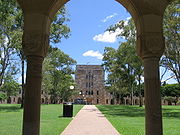Queensland Brain Institute
 The building of the Queensland Brain Institute was completed in 2007. | |
| Founder(s) | Professor Perry Bartlett |
|---|---|
| Established | October 2007 |
| Mission | Neuroscience research |
| Focus | Basic science |
| Director | Professor Pankaj Sah |
| Staff | 500 |
| Location | Building 79, University of Queensland St Lucia , , , |
| Coordinates | 27°29′58″S 153°00′42″E / 27.4994°S 153.0117°ECoordinates: 27°29′58″S 153°00′42″E / 27.4994°S 153.0117°E |
| Website | qbi |
The Queensland Brain Institute (QBI) is an Australian neuroscience research institute, located in Brisbane at the St Lucia campus of The University of Queensland. Founding director Professor Perry Bartlett AO FAA[1][2] established the QBI in 2003[3][4] with assistance from The University of Queensland, Queensland State Government, and Chuck Feeney, founder of The Atlantic Philanthropies.[5][6] The purpose-built facility was commissioned in 2004[3] and on 19 November 2007, the building was opened by former Queensland Premier Anna Bligh.[7][8]
Since 2015, Professor Pankaj Sah has been Institute director. Professor Linda Richards is the Deputy Director (Research).[citation needed]
The Institute is one of nine institutes at The University of Queensland, including the Australian Institute for Bioengineering and Nanotechnology (AIBN), the Translational Research Institute, and the Institute for Molecular Bioscience (IMB).
Research[]

Research at QBI focuses on the fundamental mechanisms of brain function and its application to brain diseases and disorders. As of 2015, the Institute housed about 500 staff and students. Four research centres currently exist within QBI:
- The Science of Learning Research Centre (SLRC), established in 2010[9]
- The Clem Jones Centre for Ageing Dementia Research (CJCADR), established in 2013.[10]
- The Asia-Pacific Centre for Neuromodulation (APCN), established in 2012[11] focuses on using deep brain stimulation to advance diagnosis and treatment of neurological diseases.
- Joint Sino-Australian Laboratory of Brainnetome,[12] a joint initiative with the Chinese Academy of Sciences' Institute of Automation (CASIA), in Beijing. It uses imaging and computational techniques.
References[]
- ^ "UQ praises Premier`s $20m for brain institute". University of Queensland. 22 January 2004.
- ^ "Professor Perry Bartlett congratulated on CSL Florey Medal win". Ministers and Assistant Ministers for the Department of Industry, Innovation and Science. 12 November 2015.
- ^ Jump up to: a b "Premier Beattie announces Queensland Brain Institute". Queensland Brain Institute. Retrieved 26 May 2017.
- ^ "Queensland Brain Institute: Science's best minds in Brisbane for 'last frontier of science'". The Courier Mail. 8 March 2016.
- ^ "Funding and contacts". Atlantic Philanthropies. 15 June 2016.
- ^ "Atlantic's Arrival in Australia". Atlantic Philanthropies. Retrieved 20 July 2017.
- ^ "University of Queensland, Queensland Brain Institute". OpenBuildings. Retrieved 26 May 2017.
- ^ "Bligh kickstarts work on $1B 'Australian-1st' Ecosciences centrepiece". Retrieved 20 June 2017.
- ^ "Science of Learning Centre". Queensland Brain Institute. Retrieved 20 June 2017.
- ^ "Premier opens Clem Jones Centre for Ageing Dementia Research". Queensland Brain Institute. 8 February 2008. Retrieved 20 June 2017.
- ^ "$10 million Asia-Pacific Centre set to make Brisbane a world leader in brain research". Centre for Clinical Research. 18 March 2012. Retrieved 20 June 2017.
- ^ "Joint Sino-Australian Laboratory of Brainnetome". Queensland Brain Institute. 18 January 2017. Retrieved 20 June 2017.
Further reading[]
- "Neuroscience of vision and aerial robotics". Queensland Brain Institute. Retrieved 10 July 2020.
Currently the group is working on four projects in the area of mid-air collision avoidance...
The work of M.V. Srinivasan's group on honey bees.
External links[]
| Wikimedia Commons has media related to University of Queensland. |
- University of Queensland
- Research institutes in Queensland
- Neuroscience research centres in Australia
- Cognitive science research institutes

